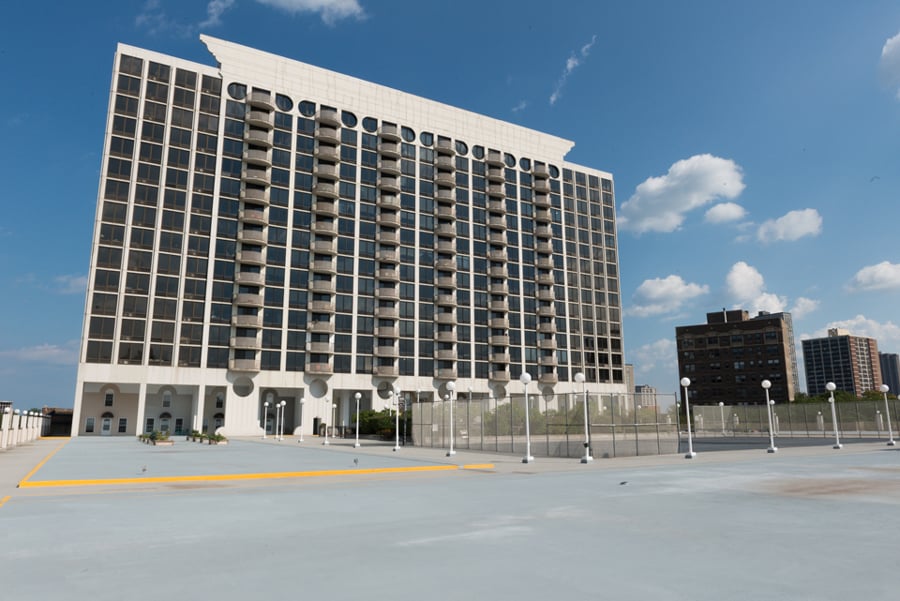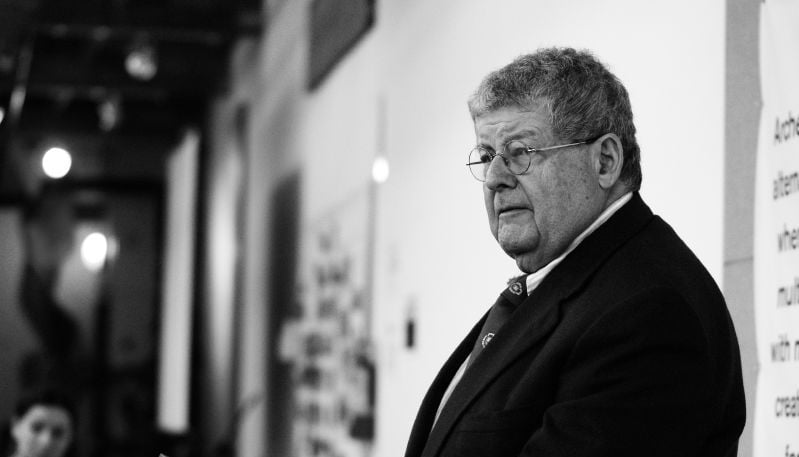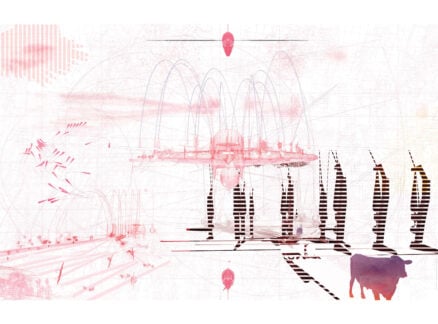
June 4, 2019
Architect Stanley Tigerman Dies at 88
Known for his idiosyncratic style, Tigerman founded his Chicago firm in 1964 and has been a seminal figure in both practice and academia.

Yesterday, the Chicago Sun-Times reported that noted Chicago architect Stanley Tigerman has passed away.
Tigerman was a Windy City native who briefly studied at MIT before joining the Navy and returning to Chicago to work for multiple firms, including SOM. He subsequently studied at the Yale School of Architecture and in 1964 Tigerman started his own Chicago practice, Stanley Tigerman and Associates Ltd., subsequently renamed Tigerman McCurry Architects. (Tigerman retired from active practice in 2017—the same year the firm closed its main office—but his wife, Margaret McCurry, continues to design under the name.)
In the 1970s, Tigerman was part of a broader movement against Modernism, a school whose “preoccupations with ideality,” he later wrote, “precluded involvement with the particular and specific in life.” He was a founding member of the Chicago Seven, a collection of Postmodernist architects that included Ben Weese, Stuart Cohen, Larry Booth, James L. Nagle, Tom Beeby, and James Ingo Freed.
Tigerman’s 1978 collage The Titanic captured the mood of the times, becoming one of the most indelible images from the period. It depicts an iconoclastic act, in which Tigerman, long a committed student of Mies van der Rohe, sinks the master’s Illinois Institute of Technology Crown Hall into Lake Michigan. He would later psychologize the gesture as cathartic, explaining that, “I was basically sinking myself. I wanted to get out from under that.” (Tigerman and McCurry shared an apartment in Mies’s Lake Shore Drive.)
While Tigerman prepared projects from Bangladesh to Japan, many of his noted works—which evidence his penchant for allegorical figures, historical styles, bright colors, and organic shapes—are in Chicago. Metropolis has included four such Chicago projects here, which were all photographed as part of an October 2015 article, “15 Buildings That Embody Chicago’s Postmodern Moment.”
If you would like to submit a statement on the passing of Stanley Tigerman, please email: [email protected]
Jimenez Lai, founder, Bureau Spectacular
Stanley Tigerman asked me to take the baton—run with it, stab him with it, stab someone else with it, pass it forward and be stabbed by it—just don’t decline it. In the baton, he asked for courage, strength, diligence, intelligence, generosity, and demanded a younger generation to take care of their own time period—even if it means laying yourself down to help your peers succeed. The idea of the baton, to me, is an idea of dedication to the ongoing cultivation of the field of architecture—something that does not die with the death of individuals, but an idea that remains alive because of all our mutual love for architecture.
I will think of Stanley often as I go on with life and work. There are lessons I will continue to think about, such as the fine line between skepticism and cynicism, irony and critique, the ineffable and the fantastical… To Stanley, architecture was a way of life, and he imparted that value onto me. Stanley Tigerman was the soul of Chicago, and he made his city a better place.
Edward Keegan, principal, Edward Keegan Architect, and contributing editor, Architect Magazine
Stanley Tigerman was profane, difficult, petty, and vengeful while in equal measures generous, humorous, intellectually curious, and encouraging (don’t look for symmetry in these; it isn’t there); Stanley was a Chicago character who shaped the city’s unique architectural legacy for more than a half century. He was deeply human, but will live on as a mythological creature—a genuine successor to Louis Sullivan, Daniel Burnham, Frank Lloyd Wright, and Mies van der Rohe in Chicago’s pantheon. He will be missed.
Thomas Kerwin, founding principal, bKL Architecture
Stanley Tigerman’s strength, passion, and advocacy on behalf of our profession has been and will continue to be a constant inspiration to me in my practice.
“Cantankerous” is often used to describe Stanley, and we all should be thankful for this. I experienced both the pleasant and not so pleasant impact of his words. Stanley was neither afraid nor inhibited by anything or anyone when it came time to stating his beliefs or defending his calling, which was architecture at its highest level.
On my last visit with him, he was in his apartment in a Mies van der Rohe–designed building, surrounded by his books, with Margaret busy at work in their home studio. He continued to offer me his words of wisdom, interrupted only by the opinions he directed to Margaret while she worked. He often told me: “It is easy to say yes, it is hard to say no”—which is great advice for any architect. And he believed strongly that architects should build their ideas, not just draw them. He encouraged us to hold to our beliefs and do what is right in realizing our work. Rest in Peace, Stanley.
Stewart Hicks, cofounder, Design With Company
When I first sat down to write about Stanley, I wanted to write something that would warrant his approval by criticizing the architectural establishment and to explain how his confidence and F.U. attitude is instilled within me. He often spoke to me about the importance of bravery, uncompromising dedication, and ruthlessness in the face of weakness, but I was more a sponge than the spear he was demanding. I was worried this meant I was failing to live up to his expectations, but he continued to accept and encourage me anyway. His approval wasn’t contingent on me being like him in the way I originally thought. What he was really demanding was for me to be a better version of me—to take a piece of him and be its steward, in my own way. I promise to deliver on this everyday, in every area of my life, and to pass it along to anyone that will listen.
Allison Newmeyer, cofounder, Design With Company
The first time I met Stanley was at his office for an appointment at our (with Stewart, my husband/partner) request. We just moved to Chicago after being away on various adventures with grad school and work. We were excited to be back and there was a feeling we returned home. Naively, we wanted to meet with Stanley to seek his guidance—to introduce ourselves and let him know we looked up to and respected him. He got right to the point by questioning why we needed to move around so much. He said, “You’re not from Chicago. We’re not going to embrace you just to have to move in a few years.” Basically, he told us it would take time and dedication to the city in order to really belong here—and then we could talk. We walked away, not with an ‘I’ll show him’ attitude, but inspired by the ‘Okay, let’s do it’ challenge.
Over time, we began proving our dedication. Fast forward to a panel discussion on drawing, set within an exhibition of his sketchbook collection. I was a little nervous. At one point, he cut me off as I was talking. “Don’t be so timid. You have a voice, and everyone wants to hear it.” I was a little embarrassed, but that was outweighed by my feelings of encouragement. Stanley wanted to know what I was thinking as a younger person and challenged me to be passionate about my own endeavors. This interaction was one of many that inspired me to know that my opinion, attitude, and outlook is valid and important—that I shouldn’t shy away from or apologize for my passions and convictions. The world is a much more interesting place when we challenge old ideas, build on them, sometimes tear them down. Thank you for your gift, Stanley.
Stuart Cohen, Professor of Architecture Emeritus, University of Illinois Chicago
Stanley Tigerman was a genius at promoting Chicago architecture. He was committed to supporting both the people he believed in as well as architectural ideas. During the late 70s and 80s I spoke with Stanley several times a day. I felt that together, we were the instigators of a conspiracy to change the culture of architecture here. We helped to create a climate that valued a diversity of practices as well as challenging the accepted narrative of Chicago’s place in the history of 20th century architecture. Stanley was incredibly supportive of talent and equally dismissive of those he considered bad architects, fools, or anyone who got in his way. He was a force. It is hard to image Chicago without his voice, but equally hard to imagine anyone replacing him as Chicago architecture’s preeminent spokesman.
Brad Lynch, principal, Brininstool + Lynch
Stanley spent a lifetime supporting excellence in architecture—his advocacy strengthened by his education of students, as well as civic leaders, practitioners, and the public alike. Through both the spoken and written word, he consistently presented an honest dialogue about contemporary issues in architecture, and for the last fifty years, Stanley was the steadfast voice of Chicago architecture. Often controversial, but never for the sake of controversy, he championed for an intelligent built environment for all social classes, and to make his city a better and more livable place.
Perhaps, nothing is more important in Stanley’s educational oeuvre than Archeworks, which he founded in 1994 with Eva Maddox. They started a school that championed design solutions for social concerns—and it worked because they were able to create viable and productive relationships between non-profits, students, instructors, and professionals that did not question the need to be involved, and who readily contributed their cumulative energies and expertise to better our society through the built environment. [statement excerpted from brininstool-lynch.com]
Ross Wimer, architecture lead, Americas and senior vice president, AECOM
I first met Stanley Tigerman when I was in graduate school. I remember vividly how he chided me for showing a large concrete wall in one of my designs. He said, “That’s like using profanity in polite conversation!” 25 years later, I had the opportunity to get to know Stanley while we worked together on the Chicago 2016 Olympic bid. Although an extraordinarily articulate man, Stanley himself would occasionally use an expletive for effect. It was by spending more time with him that I realized the true meaning of his earlier admonishment. He was not trying to tell me one should not use profanity in polite conversation, or not to use a large concrete wall in architecture. Instead, what Stanley meant was, when they are used, they are to be used in a deliberate way. Thank you, Stanley for providing me with encouragement and insight and for your thoughtful contribution to architecture. You will be missed.
Philip Enquist, consulting partner, urban design and planning, SOM
Stanley was a navigator.
He knew the destination, he knew the route. He was not a pilot. It didn’t matter how bumpy the ride was, he didn’t care. Heading in the right direction, that was what he cared about.
He knew the destination when most of us did not.
My favorite quote of Stanley’s is: “It’s about quality, quality. Absolute not relative. You don’t measure quality in relative terms. It must stand on its own. It must be absolute. “
As I said, he was a navigator. And we need more like him.
Peter Exley, cofounder, Architecture Is Fun
Like many Chicago architects, I was the recipient of Stanley Tigerman’s generosity.
I first met Stanley at a Rizzoli Bookstore signing for his children’s story, Dorothy in Dreamland, which he gifted and inscribed to our daughter Emma—coincidently the name of his grandmother. It was a small act, but a formative meeting for a young architect and his family. Later, as president of AIA Chicago, I rode on the coat-tails of his excellence in awarding him the AIA Chicago Lifetime Achievement Award. I was pleased that it happened on my watch; it’s possible that there had been some resistance to this honor previously, but making that award was the easiest decision made by the Board that year and a highlight for [the] AIA. It would be easy to make a long list of interactions. Stanley was a genuine and caring steward paying close attention to every contribution to the built environment and to architects’ ethical canon. The profession, architectural education, and Chicago especially are so much richer for his purposeful voice.
Long may his persistence, conscience, and truth guide citizen architects everywhere.
Julie Hacker, partner, Stuart Cohen Julie Hacker Architects
I arrived on the Chicago scene in the 80’s when I attended the M.A. program at UIC. There I met Stuart Cohen, who would eventually become my work and life partner. I was quickly ushered into the world of the “Chicago 7” where I met Stanley. I have to admit I had already heard stories about him and was slightly unnerved at our first meeting, although I do remember having a dialogue with him about Rabbinic Judaism. We discussed the glorious tradition of continuously questioning ideas and healthy (sometimes) debate. I soon realized that this tradition is what drove Stanley ever onward into the conceptual, theoretical aspects of architecture, some of which I agreed with [and] some which I did not.
He was always extremely supportive of me in the profession as he was with other young architects. Most importantly for me, his partnership with Margaret (an excellent architect in her own right) allowed me to envision a partnership with Stuart where we would live and work together, making a life around architecture and family. Needless to say, this is a very difficult thing to do, but the fact that Stanley and Margaret built an internationally-known firm with two important voices paved the way for so many other husband and wife firms in this City.
Martha Thorne, executive director, Pritzker Architecture Prize; dean, IE School of Architecture and Design
Stanley Tigerman participated in an exhibition I curated to celebrate Madrid as the cultural capital of Europe in 1992. Five architects were invited to imagine a future vision for Madrid. Some chose relatively open lands at the outskirts of the city. However, Stanley, in his true fashion, picked a site right next the the imposing Royal Palace. This was all Stanley—go for the big challenge, be an iconoclast, and do it with the greatest intelligence. Later, in 1996, when I moved to Chicago to work at the Art Institute, I came in regular contact with him [through] museum activities. He was a generous supporter of the Department of Architecture. Stanley Tigerman was one of Chicago’s greatest boosters. He loved the city and loved architecture. We didn’t always agree, but he always made you think, and think again. I feel a personal debt and Chicago has a collective debt to a man who always put “the second city” first!
Recent Profiles
Profiles
Chris Adamick Designs for Life


















